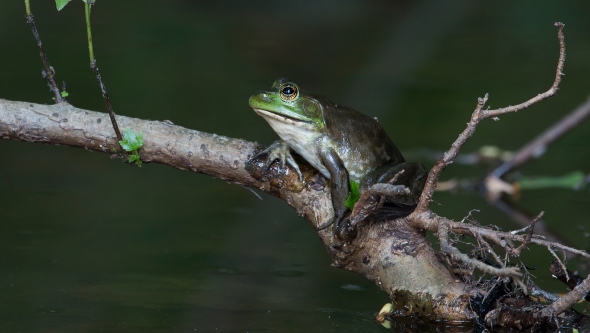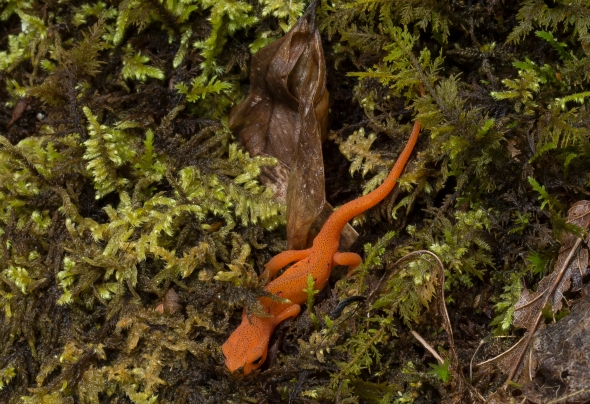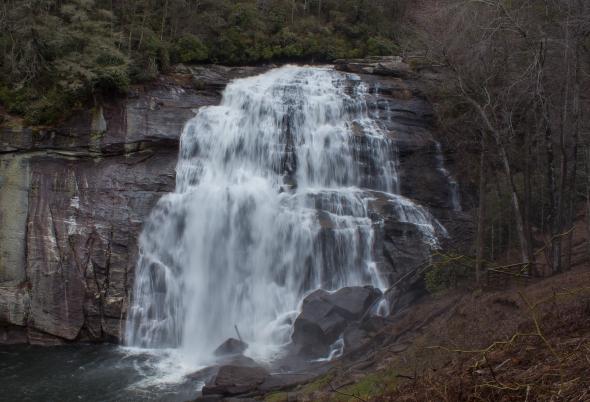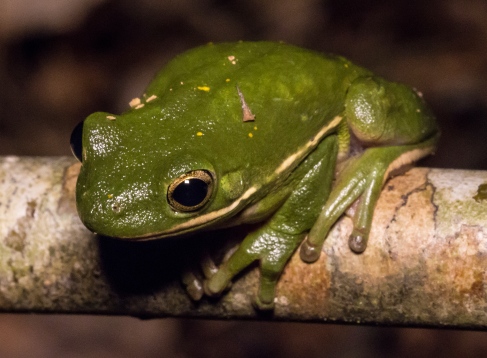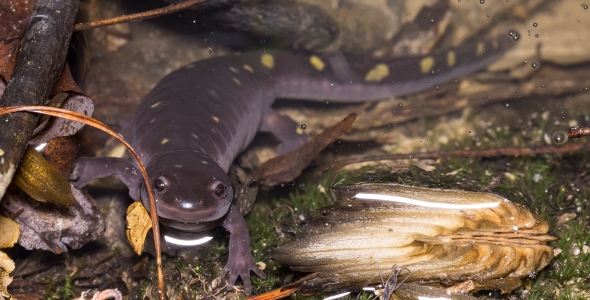Bullfrog on a Log
This is a photo of an American Bullfrog out in the small pond behind my house. This Frog on this branch is a female you can tell because the Frogs Tympanic Membrane which is the Frogs Eardrum, which the circular indention below the Frogs eye. In females the membrane is smaller than the Frogs eye. In a male Bullfrog the Tympanic Membrane is nearly twice as big as the Frogs eye. This photo was taken with a Canon 100-400mm lens and Canon Rebel T4i.
American Bullfrog
This is a photo of an American Bullfrog out in the pond behind my house. This photo was taken with a Canon Rebel T4i and Canon 100-400mm lens.
American Bullfrog on a log
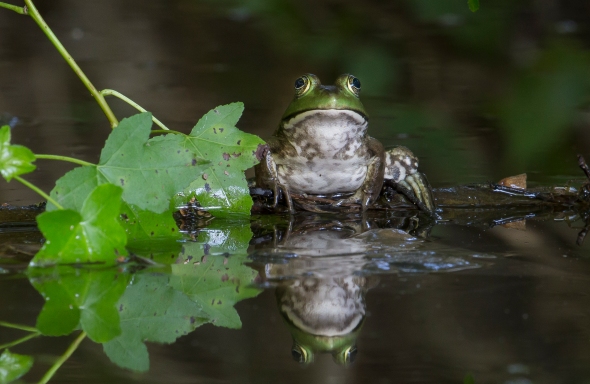
An American Bullfrog and its reflection over the water is a truly beautiful sight. In addition to photography lately I have been working on making some nature based relaxation and meditation videos. The video below shows the reflection of the bullfrog moving with the water. Both the photo above and the video below were made with a Canon Rebel T4i and a Canon 100-400mm lens.

The Lizard in this photo is a Carolina Anole. The Carolina Anole is referred to as the American Chameleon due to its ability to change colors. More information about Carolina Anoles and their ability to change colors can be found by clicking on the link below. I took this photo with a Canon Rebel T4i and a Canon 100-400mm lens
http://66.147.244.206/~lastmil5/2013/10/29/carolina-anole-the-american-chameleon/
Set Rock Creek Falls

This is a photo of Set Rock Creek Falls in the Pisgah National Forest located in Western North Carolina. This photo was taken with a Canon Rebel T4i and Canon 18-55mm lens.
EASTERN NEWT (NOTOPHTHALMUS VIRIDESCENS)

The Eastern Newt, also referred to as the Red Spotted Newt ,is found all over the East Coast of the United States. The Eastern Newt is found from Canada to the Great Lakes and as far down south as Texas and Alabama. The Eastern Newt (Notophthalmus viridescens) is the only species of Salamander that is native to North Carolina that has rough skin. Eastern Newts can be found in ponds, marshland, and slow moving streams. I found this Red Spotted Salamander while I was hiking in the Black Mountain Campground in the Pisgah National Forest located in Western North Carolina. I took these photos with a Canon Rebel T4i and Canon 100mm macro lens.
sources:
Click to access newteastern.pdf
Duggers Creek Falls
This is a photo of Duggers Creek Falls, which is Located near Linville Falls in Western North Carolina. I took this photo with a Canon Rebel T4i and and Canon 18-55mm lens.
American Toad Calling
It is Spring time here in North Carolina, and the warm weather has brought the toads back out from their burrows, and they have come out of hibernation. The American toad, as well as other frogs , have one thing on their mind after they come out of hibernation ,that is reproduction. The male toads call for the females, and the female toads select the males with the loudest calls as their mate. I took this video on the bank of a pond behind my house. Below we see a male American toad who has climbed onto the back of a female who he has attracted with his calls. When a male assumes this position it is called amplexus, which is a fancy word for mating position. As the female releases her eggs into the water in a long string ,then the male fertilizes them. I took this video and photo with a Canon Rebel T4i and Canon 100mm Macro lens. For the lighting I used a Newer CN-160 led light pod mounted to the top of my camera. Now that the weather is warm, and the frogs and toads have come back out and I am working on some documentary clips about frogs and toads of North Carolina.
sources
American Bullfrog
The Frog in this photo is an American Bullfrog. American Bullfrogs are the largest Frogs found in the United States. American Bullfrogs can measure up to 8 inches from their snout to the back of their bodies. American Bullfrogs often times sit for hours submerged in water, with all but their heads exposed, waiting for prey to come by. American Bullfrogs have a long sticky tongue that they use to snatch up prey that gets too close to them. Hopefully this Spring/Summer I will be able to either get a photograph or a video of a Bullfrog snatching up some prey with its long sticky tongue.
sources
http://animals.nationalgeographic.com/animals/amphibians/american-bullfrog/
Male Eastern Cardinal In A Tree
The bird in this photo is a Male Eastern Cardinal ,I took this photo with a Canon 100-400mm Lens and a Canon Rebel T4i. The cardinal in this photo was calling from the tree limb and and showing his tail feathers in order to attract a female.

Southern Leopard Frogs Calling
Its Spring Time here in Central North Carolina the Frogs are back out and they are calling. After a long hard winter we see that the Frogs are ready to reproduce. We can see the first Southern Leopard Frog in the video’s calls were successful in attracting a Female. The video below is a video that I shot with a Neewer 160 Led light pod and Canon RebelT4i and Canon 100mm macro lens. My next goal is to try get some video of the illusive spring Peepers calling.
Eastern Blue Jay On A Tree Limb

This is an Eastern Blue Jay in a tree taken with a Canon Rebel T4i and Canon 100-400mm lens
Cullowee Falls

This is a photo of Cullowhee Falls located in Cullowhee North Carolina. I took this photo with a Canon Rebel T4i and a Canon 18-55mm lens
Rainbow Falls Nantahala National Forest on the Horsepasture River
Rainbows Falls taken with a Canon Rebel T4i and a Canon 18-55mm lens
The Rain Has Brought The Tree Frogs Back Out
The first warm rain has brought the Tree Frogs back out of hibernation. The Frog in this photo is an American Green Tree Frog. I took this photo with a Canon Rebel T4i and Canon 100mm Macro lens. This was the last photo I was able to get before the battery in my camera died. Hopefully in the coming days I will have time to go out and look for more Tree Frogs to photograph.
Spotted Salamander
This is a photo of a Spotted Salamander. I took this photo in the small, shallow pond behind my house. I took this photo using a Canon Rebel T4i and a Canon 100mm Macro lens. The Spotted salamander is one of the Largest species of Salamanders found in North Carolina, the Spotted Salamander can be up to 9 inches in length. In the wild Spotted Salamanders can live to be up to 20 years old. The Spotted Salamander can be found in heavily forested areas in the Mountain and Piedmont regions of North Carolina. The Spotted Salamander is most active at night, and Is rarely seen because it spends most of its time underground. The Spotted salamander only comes out at night to find prey, as well in the Spring when its mating season. In my previous located below post I talked about how Spotted Salamanders lay their eggs in the early Spring in shallow pools.
sources, and more information about spotted salamander
http://animals.nationalgeographic.com/animals/amphibians/spotted-salamander/
<a
Spotted Salamander Laying Eggs
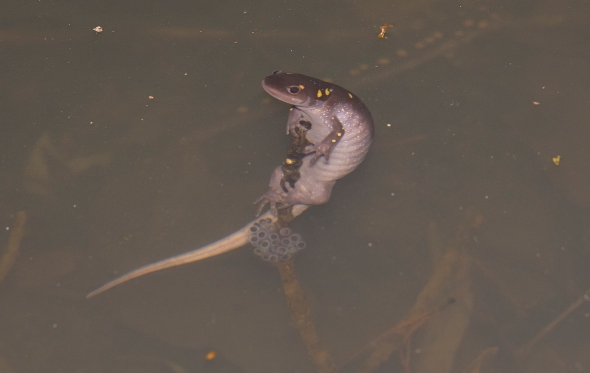
The spotted Salamander is a a large Salamander, it is one of the largest Salamanders found in North Carolina. The Spotted Salamander can be found all through the deciduous forest of Canada and the Eastern United States, The Spotted Salamanders can be found from Nova Scotia to Southern Georgia and as far west as Eastern Texas. The Spotted Salamander ranges in size from 5.9 inches to 9.8 inches long. The Spotted Salamander can live up to twenty years. Spotted Salamanders usually range in color from black, to grey, and to dark green, with yellow spots. Spotted Salamanders spend a lot of their time underground, and are rarely seen. The Spotted Salamander only only comes out after a rain and to look for food, at night. Spotted Salamanders diets consist of earthworms, snails, spiders, centipedes and other insects. Salamanders like other amphibians hibernate for the winter. Spotted Salamanders come out of hibernation in the early Spring to breed. I took this photo on a warm February night of 20014, after some pretty heavy rains had fallen. The photos show a female Spotted Salamander laying and attaching her eggs to a small twig underwater,in a very shallow pond behind my house. I took this photo using a Canon 100mm Macro Lens and Neewer 160 Led Light attached to my camera. After the eggs are laid Green Algae grows over the eggs to help camouflage the eggs so that Fish, and Frogs will not eat the eggs. Hopefully I can get some photos of these Eggs hatching as well as some photos of Spotted Salamanders on Dry land.
sources
http://www.fcps.edu/islandcreekes/ecology/spotted_salamander.html
http://animaldiversity.ummz.umich.edu/accounts/Ambystoma_maculatum/#ec3ed98d18ef60e0569c883699bfa7bf
http://animals.nationalgeographic.com/animals/amphibians/spotted-salamander/
This Warm Weather Has Brought My Amphibious Friends Back Out

This warm weather as of late has brought my Amphibian Friends back out. The Frog in this photo is a Carpenter Frog. This is the first photo I have taken with my new Canon 100mm Macro Lens.
Ive also been making progress on my new website for Last Mile Photography, http://www.lastmilephotography.com
Male Eastern Cardinal in a tree

This is a photo of a Male Cardinal in a Tree, I took this photo with a Canon Rebel and a Canon 100-400mm Lens
Junco in the Snow
I took this photo of this Junco in the snow, with my new Canon 100-400mm Camera Lens, im so excited that I finally saved up enough to afford a Canon 100-400mm lens and a Canon 100mm Macro Lens. Also ive been doing more work on my website www.lastmilephotography.com So far we’ve gotten about 5 inches of Sleet and snow here in Fuquay-Varina in Central NC. Work is cancelled tomorrow so Im going to spend all day looking for birds and other creatures to photograph in the snow.
This is a Junco in this winter storm Pax Pounding North Carolina as we speak.
Spring Peeper Chillin on a Twig
Hello Friends, I moved my lastmilephotography.wordpress.com to my own domain name. http://www.lastmilephotography.com. Im still working on getting all of the issues out of this website, as well as continuing to work on the layout and design of this website, I have a lot of big plans for this website. I cannot wait until the Spring when all of the Frogs and Toads come back out of hiding, by this Spring I will have a Canon 100mm Macro Lens, which I am very excited about. The Frog in this photo is a Spring Peeper, the Spring Peeper is one of 15 species of Tree Frogs found here in North Carolina. I took this photo with my Canon Rebel T4i and Canon 55-250 telephoto lens. Hopefully by the end of this summer I will accomplish my goal of photographing all of the Frog species found in North Carolina.
Carolina Anole showing his Dewlap
This is a photo of a carolina Anole exposing his Dewlap. The Dewlap is the red flap that the Lizard has underneath his throat. The Dewlap serves 2 purposes the Dewlap is designed to scare off predators by making the Lizard look bigger than he really is. The other purpose that a Lizards Dewlap serves is to attract and impress the females. The bigger and more vibrant the Anoles Dewlap is the better chance he has of finding a mate.
This Anole is on the Fence of my neighbors pool. I took this photo using a Canon Rebel T4i and a Canon 55-250mm Lens, this last July.
Carolina Anole On A Tree Limb
This is a photo of a Carolina Anole on a Tree Limb. I took this photo with a Canon Rebel T4i and a Sigma 70-300mm Lens.

